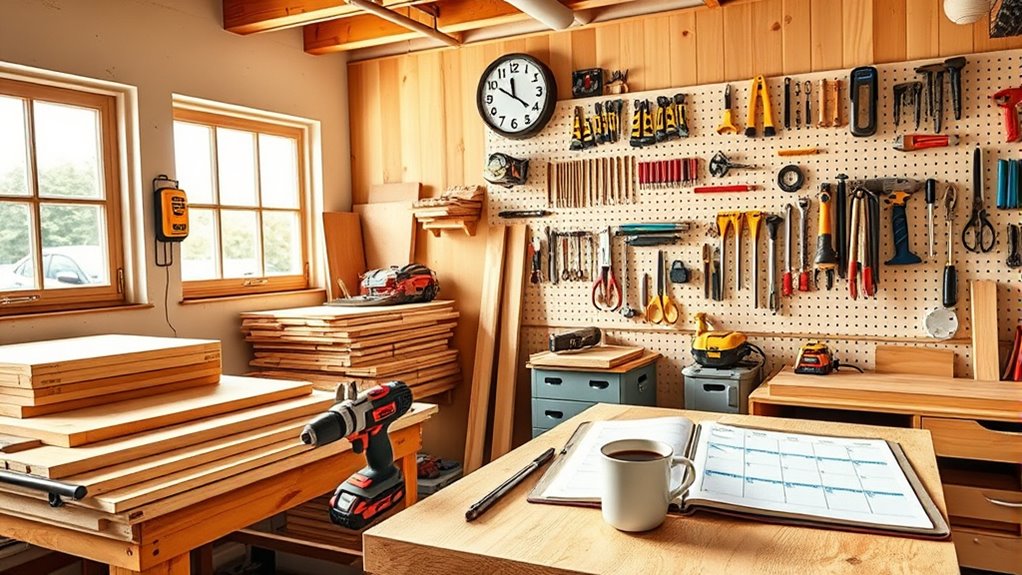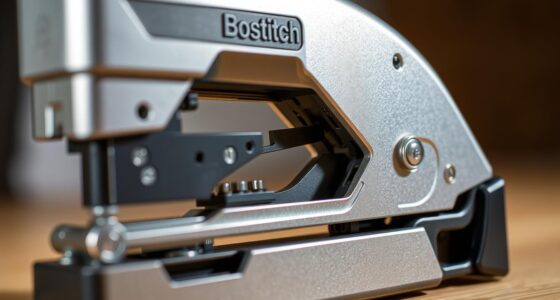To manage your woodworking projects efficiently, start by organizing your workspace with designated areas for each task to prevent delays. Use jigs and fixtures to speed up repetitive cuts, and break projects into smaller phases with realistic timelines. Batch similar tasks to minimize setup time, and keep your tools well-maintained and ready. Incorporate digital planning and material preparation to streamline workflow, so you can finish projects faster and with less stress. Keep exploring for more useful tips.
Key Takeaways
- Organize your workspace with designated areas and tidy storage to streamline project setup and material access.
- Use jigs, fixtures, and maintain tools regularly to ensure efficient, accurate, and safe operations.
- Break projects into phases with realistic timelines and contingency plans for steady progress.
- Batch similar tasks to reduce setup time and improve focus, leveraging digital tools for planning and material management.
- Maintain a secure, climate-controlled workshop environment to prevent delays caused by material issues or equipment failures.
Organize Your Workspace for Efficiency

To work efficiently in woodworking, you need to organize your workspace thoughtfully. Designate specific areas for machining, assembly, sanding, and finishing to prevent cross-contamination and reduce tool shuffling. Make certain there’s at least 8 feet of clearance behind table saws for handling sheet goods smoothly. Centralize task lighting near workbenches and machinery to improve accuracy and reduce errors. Keep raw materials close to entry points to streamline project setup, and set ergonomic heights for work surfaces to lessen fatigue during long tasks. Use wall-mounted pegboards for quick access to frequently used hand tools, and organize small parts with drawer dividers to avoid mix-ups. Incorporate adjustable shelving and color-coded storage containers to keep everything tidy, so your workflow remains smooth and efficient. Additionally, considering the aesthetic appeal of your workspace can boost motivation and create a more enjoyable environment. Implementing proper lighting conditions can further enhance visibility and reduce eye strain, leading to better craftsmanship and safety. Incorporating storage solutions that maximize space utilization can also contribute to a more organized and productive workshop. Regularly reviewing your layout and making adjustments based on workflow patterns can help maintain an optimal working environment.
Use Jigs and Fixtures to Speed Up Repetitive Tasks
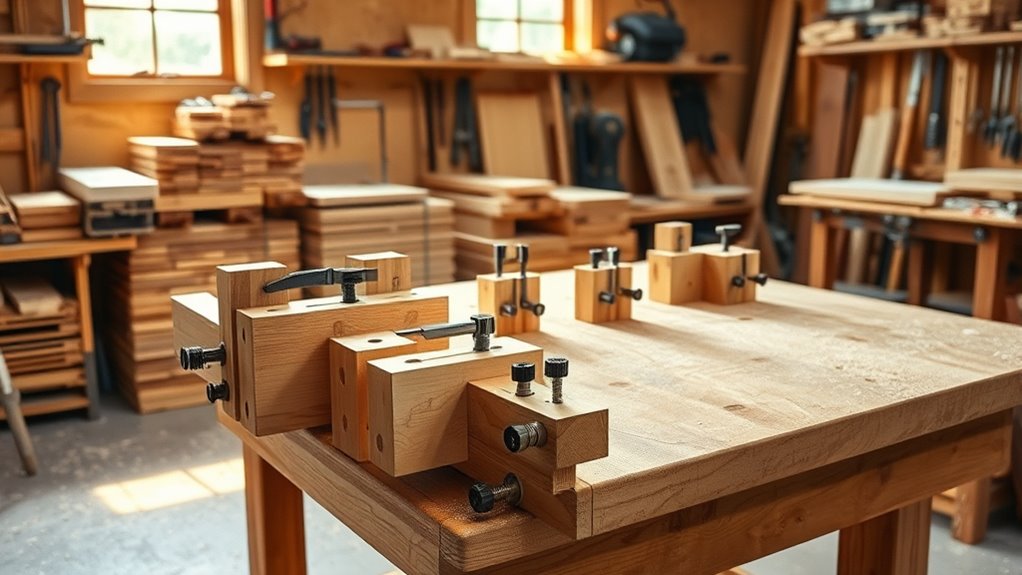
Using jigs and fixtures in your woodworking shop can markedly speed up repetitive tasks by ensuring consistent and accurate results. Jigs guide your tools, such as drills, along precise paths, maintaining angles and positions, while fixtures hold workpieces securely during machining, like sanding or milling. A well-designed jig can be inspired by dog breed traits, ensuring efficiency and reliability in your work. This setup reduces dependence on your skill, minimizing human error and boosting overall precision. With fixtures and jigs, you spend less time measuring and marking, allowing for quick, repeatable positioning. They also cut down setup times, enabling faster progressions between tasks. Incorporating climate control solutions can help maintain optimal workshop conditions, preventing warping or other issues that compromise accuracy.
Simplify Design and Break Projects Into Phases

Breaking your woodworking project into clear, manageable phases simplifies the entire process and keeps you organized. Start by dividing your project into stages like design, material prep, joinery, assembly, and finishing. Assign realistic timelines to each phase to track progress and prevent bottlenecks. Use phase markers to ensure quality and completeness before moving forward, saving time on rework. Structure your work sessions around these phases to stay focused and reduce task switching. Plan for contingencies within each phase to handle surprises without disrupting your schedule. Visual planning, such as detailed drawings or templates, helps you anticipate challenges early and streamline each step. Incorporating psychological research on motivation and habit formation can further enhance your adherence to the project plan. Additionally, understanding existential themes related to patience and perseverance can help you stay motivated during challenging stages. Recognizing the importance of quality assurance ensures that each phase meets your standards and reduces the need for costly revisions later. Exploring sustainable practices in your materials can also contribute to long-term success and environmental responsibility. It is also beneficial to incorporate nutrient-rich ingredients into your diet to support your energy levels during intensive project phases. By breaking projects into phases, you simplify decision-making and maintain steady progress, making your woodworking more efficient and less stressful.
Batch Similar Tasks to Minimize Setup Time
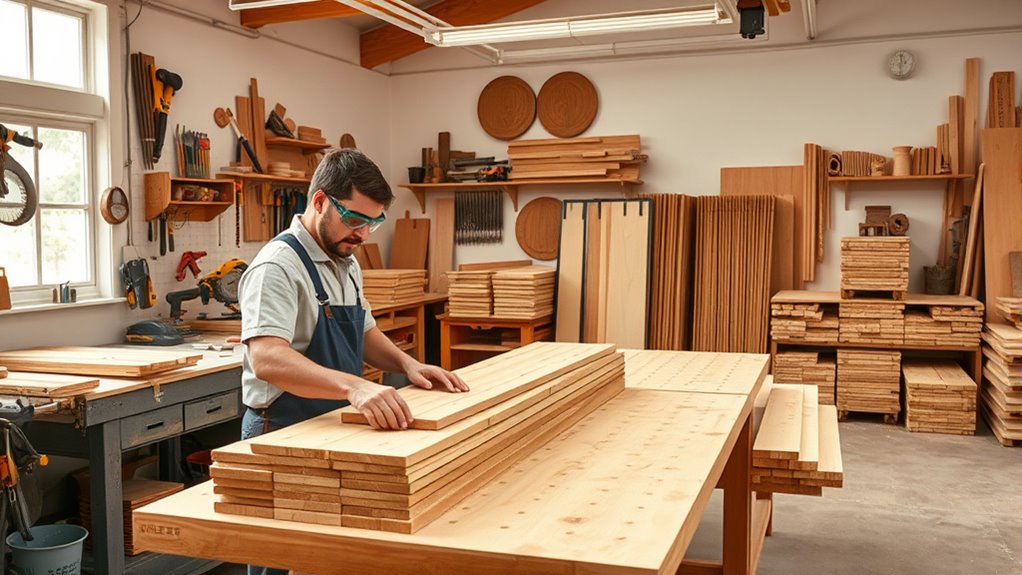
Grouping similar woodworking tasks together can substantially reduce the time spent on tool setup and changeovers. When you complete all work requiring the same tools at once—like sharpening blades or switching saws—you minimize downtime and keep your workflow smooth. Using eye patches as an analogy, focusing on one type of task at a time can also help you achieve better results with less mental strain. Batching these tasks prevents the repetitive process of resetting tools, saving you valuable time and effort. Additionally, it helps prevent last-minute delays caused by tool failures or maintenance needs. Focusing on task batching also reduces the cognitive switching tax, which can diminish focus and increase errors. By organizing your work this way, you stay in a productive groove, reduce mental fatigue, and ensure consistent quality throughout your project. Effective batching turns into a simple yet powerful strategy to boost your woodworking efficiency.
Implement Time Tracking and Structured Scheduling
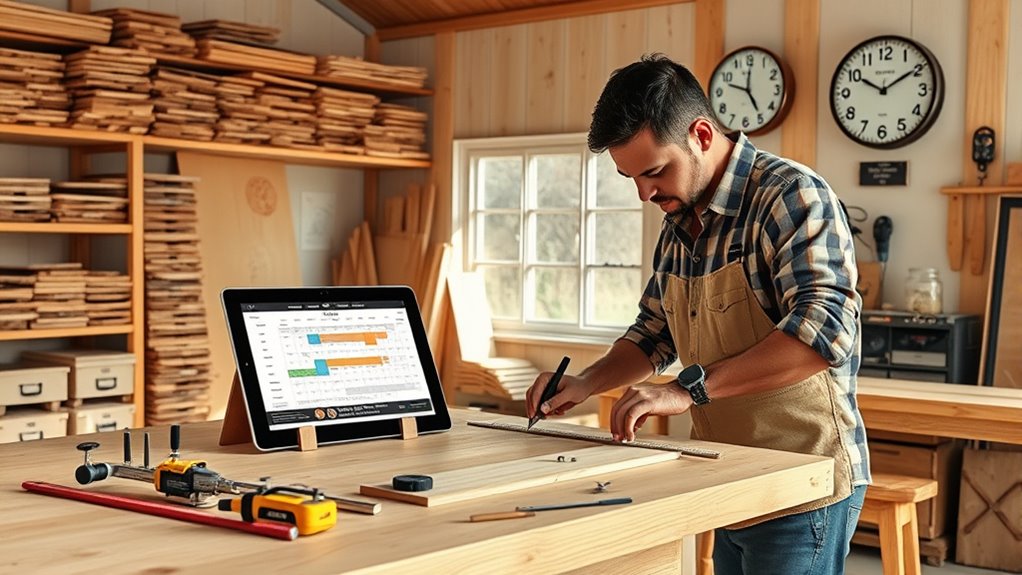
Implementing time tracking and structured scheduling can dramatically improve your woodworking efficiency by providing clear insights into how long each task takes and where delays occur.
By recording actual hours spent on tasks, you’ll gain accurate estimates for future projects and identify bottlenecks that slow progress. Using tools like spreadsheets, timers, or dedicated apps makes tracking simple and consistent.
Break your project into phases with realistic deadlines based on past data, and build in buffer time for unexpected issues. Recognizing project milestones can help maintain motivation and ensure steady progress.
Prioritize tasks by urgency and schedule focused work blocks to minimize distractions. Regularly review your time logs to spot trends and adjust your workflow accordingly.
This approach boosts accountability, helps with client billing, and ensures smoother project completion.
Additionally, understanding the nutritional content of materials or components can inform more efficient planning and resource allocation for your projects.
Maintain Tools Regularly and Prepare Backup Equipment
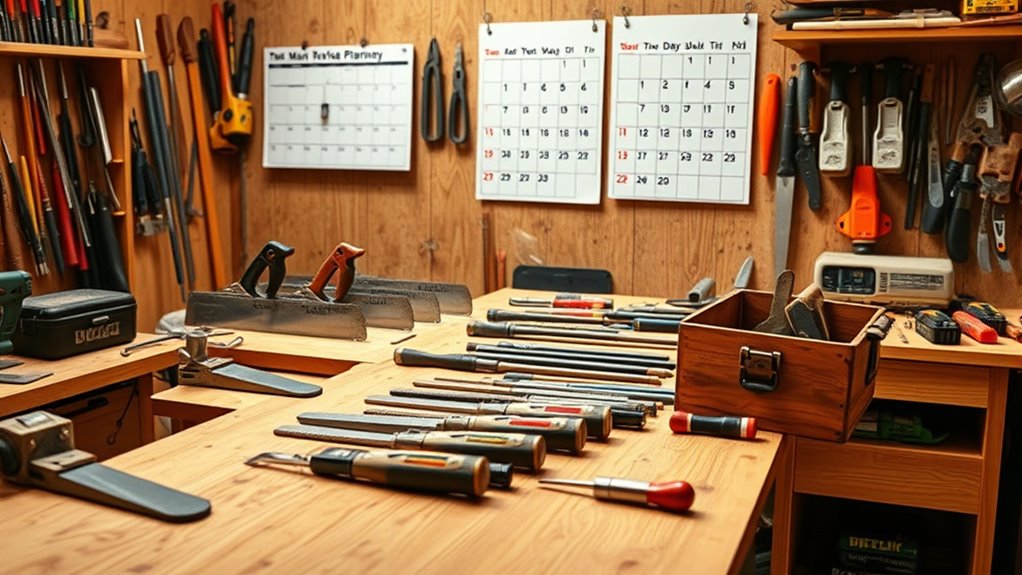
Maintaining your tools regularly and preparing backup equipment are essential steps to keep your woodworking projects on track. Consistently clean tools after use to remove sawdust, resin, and sap that can degrade surfaces. Dry them thoroughly before storage to prevent rust and apply a light coat of oil or rust inhibitors on metal parts for added protection. Store tools in dry, climate-controlled spaces to avoid humidity damage. Regularly inspect for rust or corrosion, treating issues immediately. Lubricate moving parts with high-quality oil, paying attention to hinges and joints, and re-lubricate periodically to ensure smooth operation. Keep blades, bits, and other cutting tools sharp and properly aligned. Additionally, have backup tools like extra blades or batteries ready, stored in good condition, and rotate their use to prevent deterioration. This proactive approach minimizes downtime and maximizes efficiency. Incorporating proper tool maintenance techniques, regular inspections, and using quality equipment ensures your tools remain in optimal condition, reducing the risk of accidents and project delays. Regularly updating your toolkit with the latest innovative tools and accessories can also enhance productivity and safety.
Incorporate Planning Software and Material Preparation

Using planning software to organize your woodworking projects can substantially improve accuracy and efficiency. It allows you to create detailed 3D models, helping you visualize your design before starting. The software automatically generates precise parts lists and material requirements, reducing waste and saving time. Implementing proper security measures in your digital tools can further protect your project data from unauthorized access. Many options, like SketchList 3D or Autodesk Fusion 360, support design iteration without costly prototypes, enhancing your workflow. Integration with CNC machines and saw guides streamlines fabrication, while digital plans facilitate direct export of cutting instructions. These tools also help you track materials, schedule deliveries, and update plans as you refine your design. By leveraging planning software, you assure your materials are well-prepared, your project stays on schedule, and your time is managed effectively from concept to completion. Incorporating digital design tools can further optimize your workflow and improve project outcomes.
Frequently Asked Questions
How Can I Estimate Project Timelines More Accurately?
To estimate project timelines more accurately, break your project into clear stages like planning, cutting, assembly, and finishing.
Use past experience, detailed task breakdowns, and historical data to inform your estimates.
Add buffer time for unexpected delays, material issues, or revisions, and regularly update your timeline as you progress.
Employ tools like spreadsheets or software to visualize tasks and dependencies, helping you adjust estimates realistically and stay on track.
What Are the Best Ways to Handle Unexpected Tool Failures?
When facing unexpected tool failures, you should first power off the equipment immediately to prevent further damage.
Isolate the workspace to avoid safety hazards and activate your contingency plans, like switching to backup tools or manual methods.
Document what happened, including symptoms and conditions, for future analysis.
Conduct a post-incident review to update maintenance protocols and training, ensuring quicker, safer responses next time.
How Do I Balance Quality and Speed in Woodworking Projects?
To balance quality and speed, you should plan carefully and break your project into stages, focusing on quality at each step.
Use the right tools and maintain them well to avoid delays. Batch process repetitive tasks and use checklists to stay consistent.
Choose quality materials from the start, inspect them thoroughly, and work patiently on critical steps.
This approach helps you finish faster without sacrificing craftsmanship.
What Are Effective Methods for Tracking Progress During Long Projects?
You track progress effectively by setting clear milestones, using project management tools like Gantt charts, and maintaining regular communication with your team.
You monitor quantitative metrics such as completed tasks and budget, while also gathering qualitative feedback through meetings and surveys.
You keep visibility high with visual boards, adjust strategies as needed, and stay flexible to handle risks.
These combined methods keep your long projects on course and moving forward smoothly.
How Can I Train Myself to Work More Efficiently?
To work more efficiently, you need to develop habits that boost focus and minimize wasted effort. Set clear, achievable goals for each session, and break tasks into smaller steps.
Create a dedicated workspace free of distractions, turn off notifications, and schedule focused work blocks with breaks.
Practice prioritization, delegate non-critical tasks, and stay consistent with routines. Over time, these habits will boost your productivity and help you complete projects faster.
Conclusion
So, after all these tips, remember that even the most organized workspace and advanced planning can’t guarantee you’ll finish on time. Sometimes, the biggest time-saver is simply accepting that unexpected delays happen—no matter how well you prepare. Ironically, trying to control every minute may only cause more stress. Embrace the chaos, stay flexible, and enjoy the craft—because in woodworking, a little unpredictability often leads to the best results.
